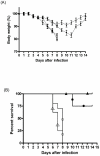A recombinant influenza A virus expressing domain III of West Nile virus induces protective immune responses against influenza and West Nile virus
- PMID: 21541326
- PMCID: PMC3082541
- DOI: 10.1371/journal.pone.0018995
A recombinant influenza A virus expressing domain III of West Nile virus induces protective immune responses against influenza and West Nile virus
Abstract
West Nile virus (WNV) continues to circulate in the USA and forms a threat to the rest of the Western hemisphere. Since methods for the treatment of WNV infections are not available, there is a need for the development of safe and effective vaccines. Here, we describe the construction of a recombinant influenza virus expressing domain III of the WNV glycoprotein E (Flu-NA-DIII) and its evaluation as a WNV vaccine candidate in a mouse model. FLU-NA-DIII-vaccinated mice were protected from severe body weight loss and mortality caused by WNV infection, whereas control mice succumbed to the infection. In addition, it was shown that one subcutaneous immunization with 10(5) TCID(50) Flu-NA-DIII provided 100% protection against challenge. Adoptive transfer experiments demonstrated that protection was mediated by antibodies and CD4+T cells. Furthermore, mice vaccinated with FLU-NA-DIII developed protective influenza virus-specific antibody titers. It was concluded that this vector system might be an attractive platform for the development of bivalent WNV-influenza vaccines.
Conflict of interest statement
Figures




Similar articles
-
A plant-produced vaccine protects mice against lethal West Nile virus infection without enhancing Zika or dengue virus infectivity.Vaccine. 2018 Mar 27;36(14):1846-1852. doi: 10.1016/j.vaccine.2018.02.073. Epub 2018 Feb 26. Vaccine. 2018. PMID: 29490880 Free PMC article.
-
A VLP-based vaccine targeting domain III of the West Nile virus E protein protects from lethal infection in mice.Virol J. 2010 Jul 6;7:146. doi: 10.1186/1743-422X-7-146. Virol J. 2010. PMID: 20604940 Free PMC article.
-
Immunization of flavivirus West Nile recombinant envelope domain III protein induced specific immune response and protection against West Nile virus infection.J Immunol. 2007 Mar 1;178(5):2699-705. doi: 10.4049/jimmunol.178.5.2699. J Immunol. 2007. PMID: 17312111
-
Lessons Learned from West Nile Virus Infection:Vaccinations in Equines and Their Implications for One Health Approaches.Viruses. 2024 May 14;16(5):781. doi: 10.3390/v16050781. Viruses. 2024. PMID: 38793662 Free PMC article. Review.
-
Mapping and analysis of West Nile virus-specific monoclonal antibodies: prospects for vaccine development.Expert Rev Vaccines. 2007 Apr;6(2):183-91. doi: 10.1586/14760584.6.2.183. Expert Rev Vaccines. 2007. PMID: 17408368 Review.
Cited by
-
Attenuated Influenza Virions Expressing the SARS-CoV-2 Receptor-Binding Domain Induce Neutralizing Antibodies in Mice.Viruses. 2020 Sep 5;12(9):987. doi: 10.3390/v12090987. Viruses. 2020. PMID: 32899480 Free PMC article.
-
Intranasal influenza-vectored vaccine expressing pneumococcal surface protein A protects against Influenza and Streptococcus pneumoniae infections.NPJ Vaccines. 2024 Dec 19;9(1):246. doi: 10.1038/s41541-024-01033-5. NPJ Vaccines. 2024. PMID: 39702744 Free PMC article.
-
Viral vectored vaccines: design, development, preventive and therapeutic applications in human diseases.Signal Transduct Target Ther. 2023 Apr 7;8(1):149. doi: 10.1038/s41392-023-01408-5. Signal Transduct Target Ther. 2023. PMID: 37029123 Free PMC article. Review.
-
Induction of protective CD4+ T cell-mediated immunity by a Leishmania peptide delivered in recombinant influenza viruses.PLoS One. 2012;7(3):e33161. doi: 10.1371/journal.pone.0033161. Epub 2012 Mar 21. PLoS One. 2012. PMID: 22470440 Free PMC article.
-
An inactivated cell culture Japanese encephalitis vaccine (JE-ADVAX) formulated with delta inulin adjuvant provides robust heterologous protection against West Nile encephalitis via cross-protective memory B cells and neutralizing antibody.J Virol. 2013 Sep;87(18):10324-33. doi: 10.1128/JVI.00480-13. Epub 2013 Jul 17. J Virol. 2013. PMID: 23864620 Free PMC article.
References
-
- Mostashari F, Bunning ML, Kitsutani PT, Singer DA, Nash D, et al. Epidemic West Nile encephalitis, New York, 1999: results of a household-based seroepidemiological survey. Lancet. 2001;358:261–264. - PubMed
-
- Pawelec G, Rehbein A, Haehnel K, Merl A, Adibzadeh M. Human T-cell clones in long-term culture as a model of immunosenescence. Immunol Rev. 1997;160:31–42. - PubMed
-
- Ligthart GJ, Corberand JX, Fournier C, Galanaud P, Hijmans W, et al. Admission criteria for immunogerontological studies in man: the SENIEUR protocol. Mech Ageing Dev. 1984;28:47–55. - PubMed
-
- Gubler DJ. The continuing spread of West Nile virus in the western hemisphere. Clin Infect Dis. 2007;45:1039–1046. - PubMed
Publication types
MeSH terms
Substances
LinkOut - more resources
Full Text Sources
Medical
Research Materials

